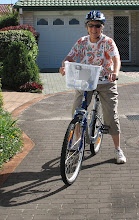
It’s about time the media took seriously their responsibilities towards people with mental illness.
A badly worded story can do far reaching damage to sufferers and their families, and yet some newspapers and television journalists are insensitive beyond belief.
One of the newspapers that circulates in our local area disgraced itself last week be printing large photographs and stories featuring a man whose actions may have pointed towards him suffering a mental illness. In fact the newspaper story stated that an ambulance later took the young man for psychiatric assessment at the local hospital.
The young man was not doing anything consciously threatening, terrible or destructive. He was simply acting in a way about which he may have been unaware and which he probably wouldn't want published for all the world to see.
And yet the newspaper, the Tweed Daily News, chose to spread this embarrassment all over the front of its week-end issue and spilled it to fill most of an inside page. Thankfully, these pictures and stories attracted condemnation from the general public, and from the journalists' peers.
The Daily News is published in the Tweed Valley on the North Coast of New South Wales in Australia.
I’m not going to repeat the crime here by reproducing evidence of this cruel act, but I do wish to chastise the newspaper for being self-serving, ignorant and extremely clumsy, to say the least.
Media too often feeds on sensationalism, and time and again sells newspapers and explodes ratings at the expense of unfortunate people. It was great to see the public reaction this time was the absolute opposite.
However, the Daily News is certainly not alone in displaying insensitivity, even though their example was astonishing.
Surveys of Australian media have shown that one fifth of items on mental illness still used language such as "cracked up", "crazy lunatics", "nutcase", "a psycho" and "mental hospital".
In 50% of cases, the method of self-harm in reporting of suicide was described in detail. This is despite recommendations that the method of suicide not be described less copycat behaviour result.
Sane Australia is an organisation doing great work in this area, attempting to educate the media about how to approach this fraught subject without doing damage.
Its web site can be found at http://www.sane.org/media/media/sane_media_centre.html
Featured is Sane’s Stigma Watch programme which monitors media portrayals of mental illness and suicide, to ensure that they are accurate and respectful. If they’re not Sane tells them so, and suggests educational programmes to stop it happening again.
The Australian Government’s Mindframe National Media Initiative has a stunningly good web site. Mindframe was produced to inform appropriate reporting of suicide and mental illness, to minimise harm and copycat behaviour, and reduce stigma and discrimination.
It was developed with the assistance of media professionals, suicide and mental health experts and consumer organisations.
One section discusses the portrayal of these issues on the stage and screen in Australia.
There are also resources for media, police, courts, and health professionals. See
http://www.mindframe-media.info/
Personally, I’d also recommend these sites to every person interested in helping others cope with mental illness. To understand the issues, and spreading the word are themselves priceless contributions.
Wiping out stigma is a major concern if we are to reduce the impact of mental illness in our communities.
POST SCRIPT:
The Australian Broadcasting Corporation television programme Media Watch last night featured criticism of the Tweed Daily News stories and photographs.
Presenter Jonathon Holmes called the newspaper 'a little rag'. The programme carried comments from the young man's father who also castigated the newspaper and confirmed that his son suffered a serious mental illness.
He said the young man had hoped the news team would help him, and was upset when they didn't.
The father said his son saw the articles and went missing for four days. He was subsequently admitted to the local psychiatric unit for treatment.
Perhaps the Daily News may now begin training their staff about respect for mentally ill persons.
Perhaps they will make mandatory the study of the Australian Government's superb website Mindframe - http://www.mindframe-media.info/
Do you know why it is not acceptable to call a person ‘a schizophrenic’?
POST SCRIPT:
The Australian Broadcasting Corporation television programme Media Watch last night featured criticism of the Tweed Daily News stories and photographs.
Presenter Jonathon Holmes called the newspaper 'a little rag'. The programme carried comments from the young man's father who also castigated the newspaper and confirmed that his son suffered a serious mental illness.
He said the young man had hoped the news team would help him, and was upset when they didn't.
The father said his son saw the articles and went missing for four days. He was subsequently admitted to the local psychiatric unit for treatment.
Perhaps the Daily News may now begin training their staff about respect for mentally ill persons.
Perhaps they will make mandatory the study of the Australian Government's superb website Mindframe - http://www.mindframe-media.info/
Do you know why it is not acceptable to call a person ‘a schizophrenic’?
Could bad media reporting result in a person with mental illness committing suicide?
Did you know that 20 per cent of Australians experience some form of mental illness at some time in their lives, and that this figure is repeated in many other nations?













